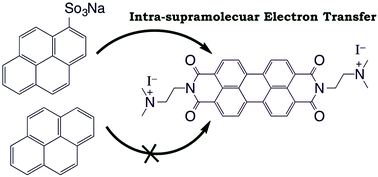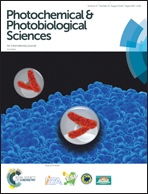Intramolecular electron transfer of light harvesting perylene–pyrene supramolecular conjugate†
Abstract
Electronic interactions between the cationic N,N′-bis(2(trimethylammonium iodide) ethylene)perylene-3,4,9,10-tetracarboxyldiimide (TAIPDI) with two electron donors, namely, pyrene (Py) and 1-pyrenesulfonic acid sodium salt (PySA), have been investigated. The spectroscopic studies showed the formation of the supramolecular conjugate between TAIPDI and PySA via ionic interaction, but not with Py. Density functional theory (DFT) combined with a natural energy decomposition analysis (NEDA) technique showed an S-like structure of the supramolecular conjugate TAIPDI–PySA via an ionic interaction. The formation constant of the TAIPDI–PySA supramolecular conjugate was determined to be 3.0 × 104 M−1, suggesting a fairly stable complex formation. The excited state events were monitored by both steady state and time-resolved emission techniques. Upon excitation, the quenching pathways via the singlet-excited states of TAIPDI and PySA involved the intramolecular electron transfer from the electron donating PySA to the electron accepting TAIPDI with a rate constant of 1.10 × 1011 s−1 and a quantum yield of 0.99. The thermodynamic parameters of the supramolecular TAIPDI–PySA conjugate have been determined using the stopped-flow technique.



 Please wait while we load your content...
Please wait while we load your content...